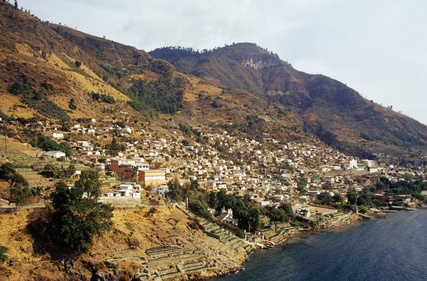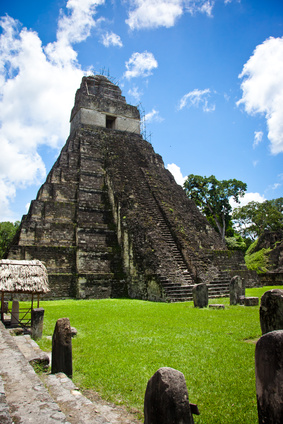 Guatemala shares its borders with Mexico, Belize, Honduras, and El Salvador. Although having a beautiful countryside, politically it was a nation plagued with civil war that lasted over 30 years; from 1960 through 1996. This civil war was between the rural Mayan peoples and the rich urban Ladrinos. As a result of this war, many were forced to flee, which created much polarization within the populations. Breakup of families was one of the biggest contributing factors. This split of families added to the hardening of opposition between both groups. The war was a deathly one. Although today both sides claim peace, there is still much animosity from a time not so very long ago.
Guatemala shares its borders with Mexico, Belize, Honduras, and El Salvador. Although having a beautiful countryside, politically it was a nation plagued with civil war that lasted over 30 years; from 1960 through 1996. This civil war was between the rural Mayan peoples and the rich urban Ladrinos. As a result of this war, many were forced to flee, which created much polarization within the populations. Breakup of families was one of the biggest contributing factors. This split of families added to the hardening of opposition between both groups. The war was a deathly one. Although today both sides claim peace, there is still much animosity from a time not so very long ago.
Today, the high contrast between rich and poor still exists. Twenty two different divisions exist within the country and each brings about its own richness and uniqueness. Although similar, foods are cooked differently from region to region. In addition, the many Mayan villages are distinctive with their vibrant and beautiful clothing and colors. This is a must see.
Authors and their Contributions in Guatemala
 Guatemala-pyramid Not only is Guatemala brimming with tradition and culture, but it is also rich in literature. The origins of Guatemalan literature can be traced back to The Popol Vuh manuscript which dates back to the 16th century and was thought to be lost. However, in the 18th century, a Friar named Francisco Ximenez discovered its existence and had a copy of this manuscript done. Today, this copy can be found in the Library of Chicago. This was published during Pre-Columbian American times and it describes Mayan stories and legends. It has been a helpful tool to preserving Mayan traditions and adds to the history of this great people. Some people consider it the Mayan Bible due to its combination of historical, mythical, and religious elements.
Guatemala-pyramid Not only is Guatemala brimming with tradition and culture, but it is also rich in literature. The origins of Guatemalan literature can be traced back to The Popol Vuh manuscript which dates back to the 16th century and was thought to be lost. However, in the 18th century, a Friar named Francisco Ximenez discovered its existence and had a copy of this manuscript done. Today, this copy can be found in the Library of Chicago. This was published during Pre-Columbian American times and it describes Mayan stories and legends. It has been a helpful tool to preserving Mayan traditions and adds to the history of this great people. Some people consider it the Mayan Bible due to its combination of historical, mythical, and religious elements.
In the late 17th century, Francisco Antonio de Fuentes y Guzman published Historia de Guatemala. This literary work is recognized as one of the most influential works in Guatemalan history detailing much of the colonial living of that time. It provides news of the country and its people and his book explains in great detail the origins of Guatemala.
Guatemala’s independence didn’t happen until 1821; however, there were many writers that wrote about the political turmoil during this era. Jose Batres Montufar was one of those authors. Although a political man, he also became one of the most prolific leading writers of that time. This was due to his unique command of literature. He used this writing skill to express his frustrations with Guatemala and the political turmoil that saturated his country. His most famous works are Don Pablo and El Relox.
Through the years, Guatemalan literature has become stronger and stronger with many other talented writers. Augusto Monterroso was awarded the Guatemala National Prize in Literature. He was a leader during Latin America’s boom generation. He mostly wrote short stories; however, his greatest works are Lo Demas es Silencio, La Palabra Magica, and La Voca.
Another great playwright is Carlos Solorzano. He is considered to be one of the best in Guatemalan history. He also went on to win the Guatemalan National Prize in Literature. Just like many other playwrights, he also contributed to the literature world by writing articles in theatre journals and enhancing that arena; many were essays concerning Latin performing arts. His most famous works are Las Manos de Dios, La Sin Ventura, and Tres Actos.
In addition to these great playwrights, one of the greatest writers known to Guatemalan history is Miguel Angel Asturias. Asturias is known as a poet, a playwright, a journalist, and also a diplomat. Although Asturias spent most of his brilliant career in isolation due to a non liberal government, he still managed to win almost every major literary award possible in South America. Asturias’ works were influenced by his Mayan beliefs and political convictions. His works were a contribution to the world as it drew notice to the significance of indigenous cultures; mostly those from Guatemala. His most famous work is El Senor Presidente and is a first person narrative about life under a dictator. His other masterpiece is Men of Maize, which centers on an Indian community facing the threat of outsiders. His most powerful work is the Banana Trilogy. His commentary on the foreign control of the banana industry in Guatemala and how Guatemalan natives were taken advantage of led him to receive the Lenin Peace Prize named after Soviet Union President Vladimir Lenin. He passed away at the age of 74 and was buried in Paris.
Publishing material that stood in opposition to Guatemala’s previous policies meant fearing for your life. Today, things are better but not totally. Current laws are much more lenient, but certain topics are still censored. Many human rights activists who write about issues such as genocide still have a hard time getting their work published in Guatemala because of the fear of negative publicity. Today, many writers still continue to be harassed or thrown in jail because of their modern thinking and forthright agendas.




